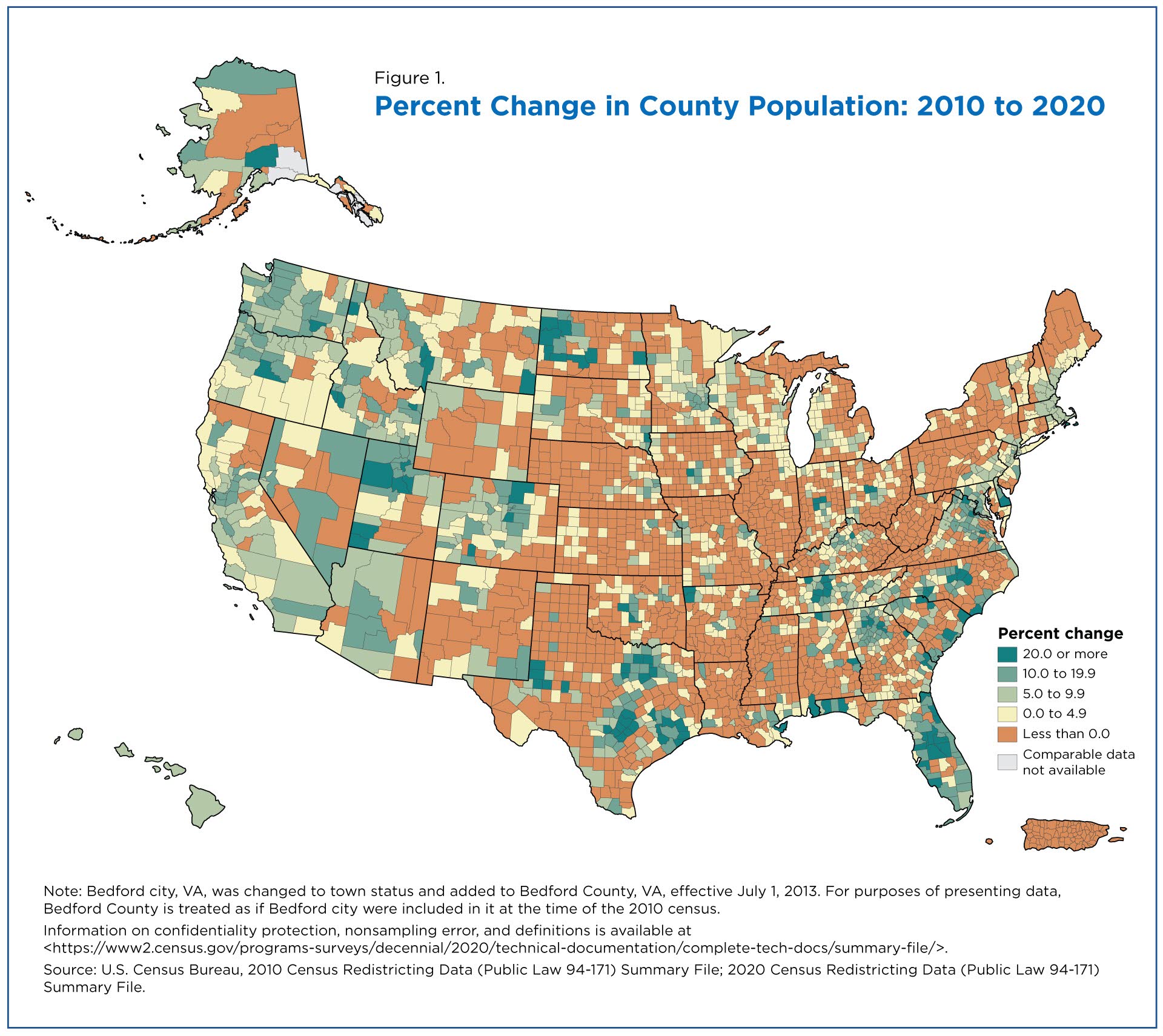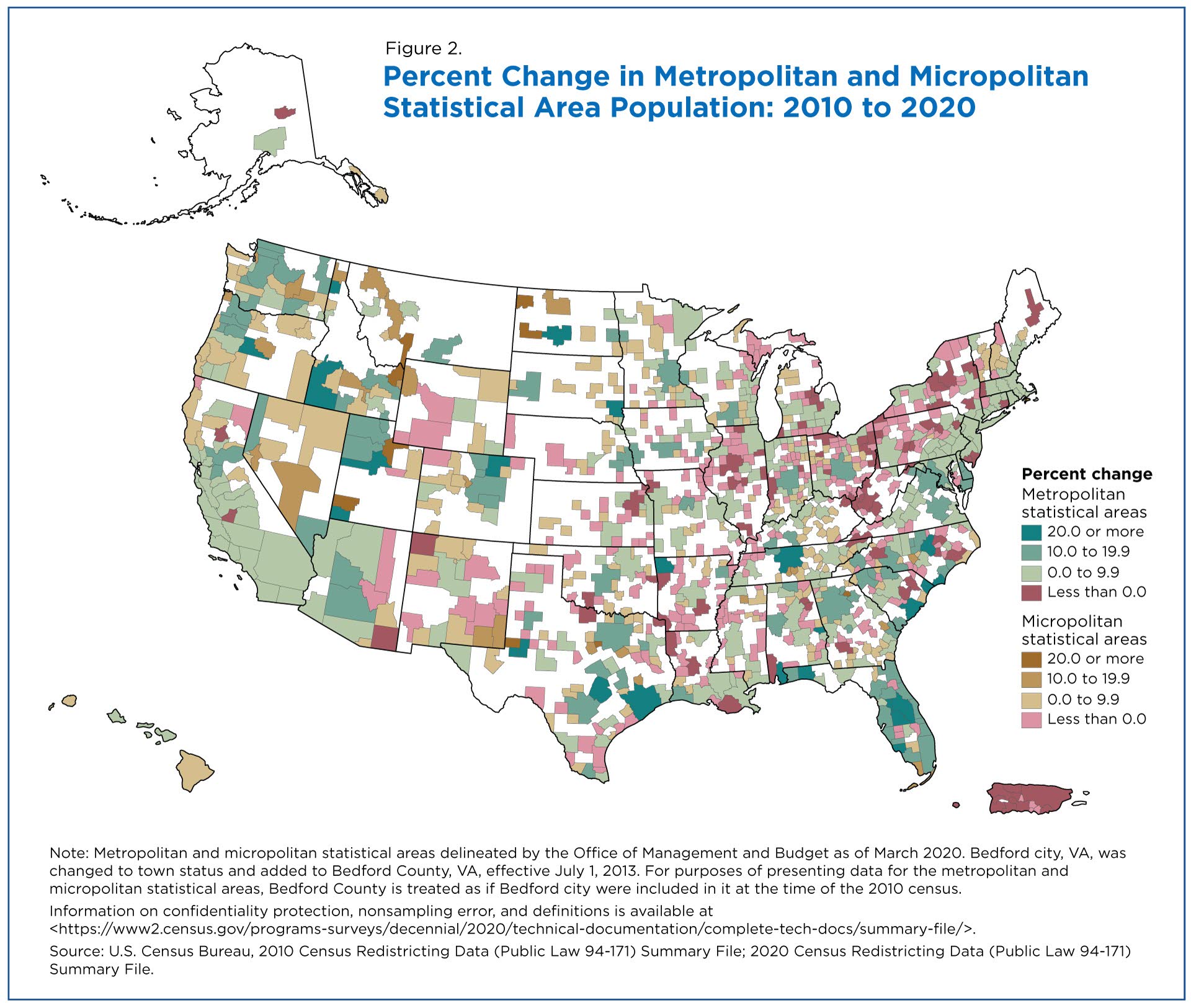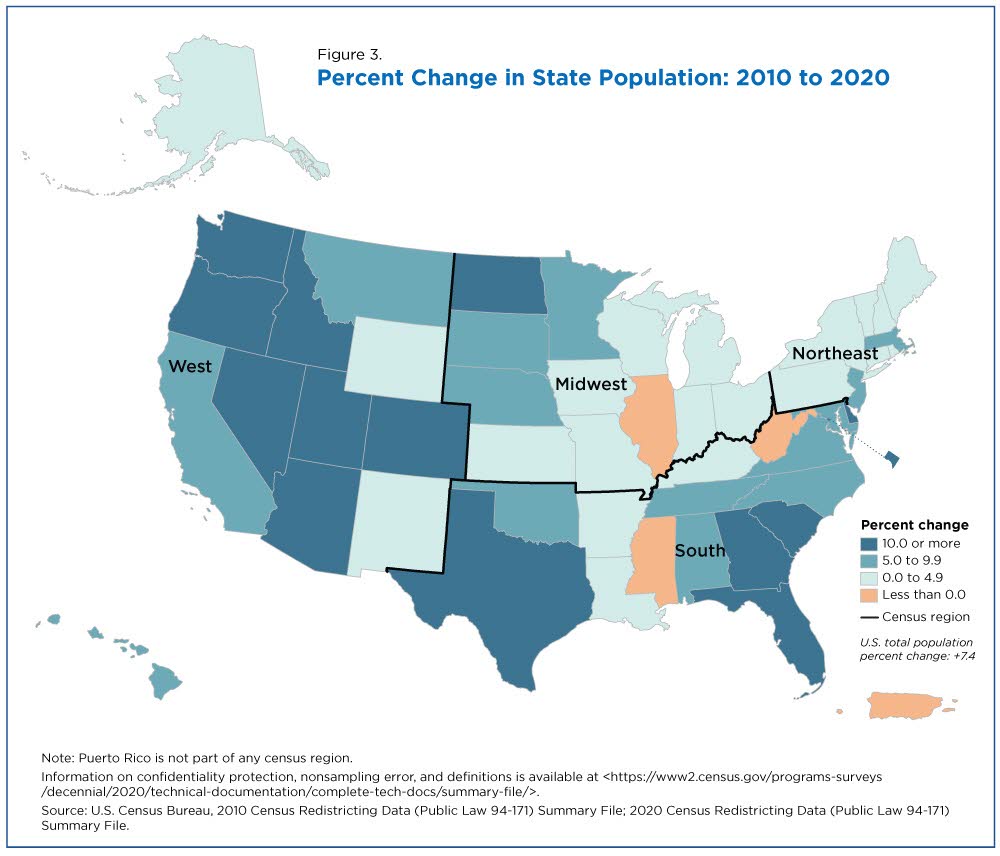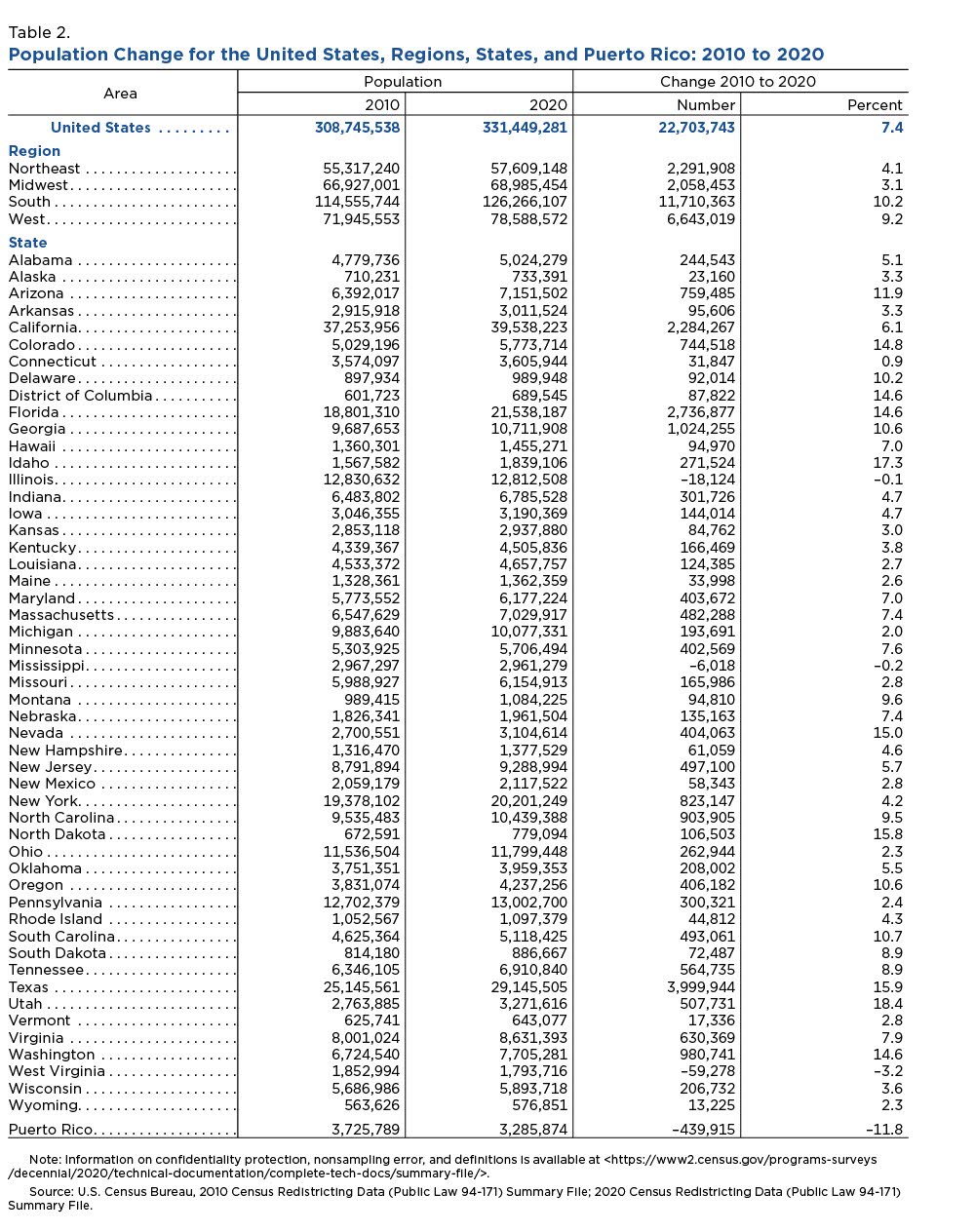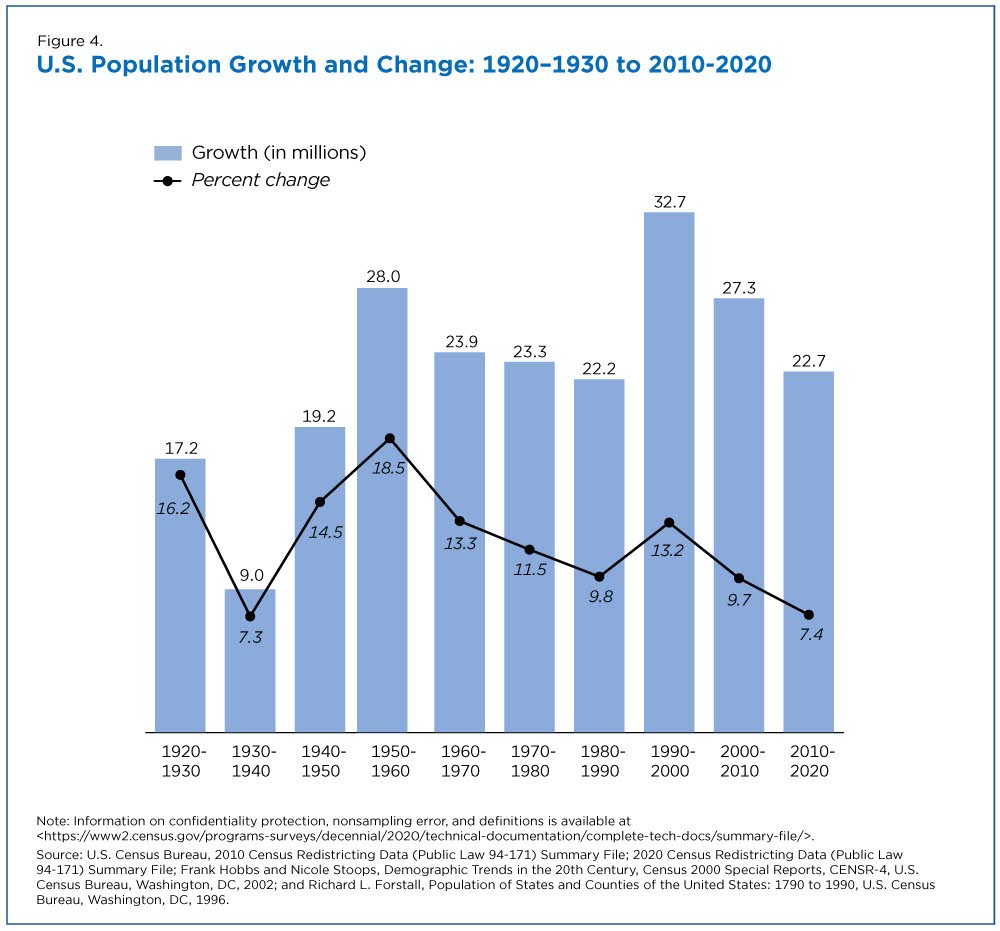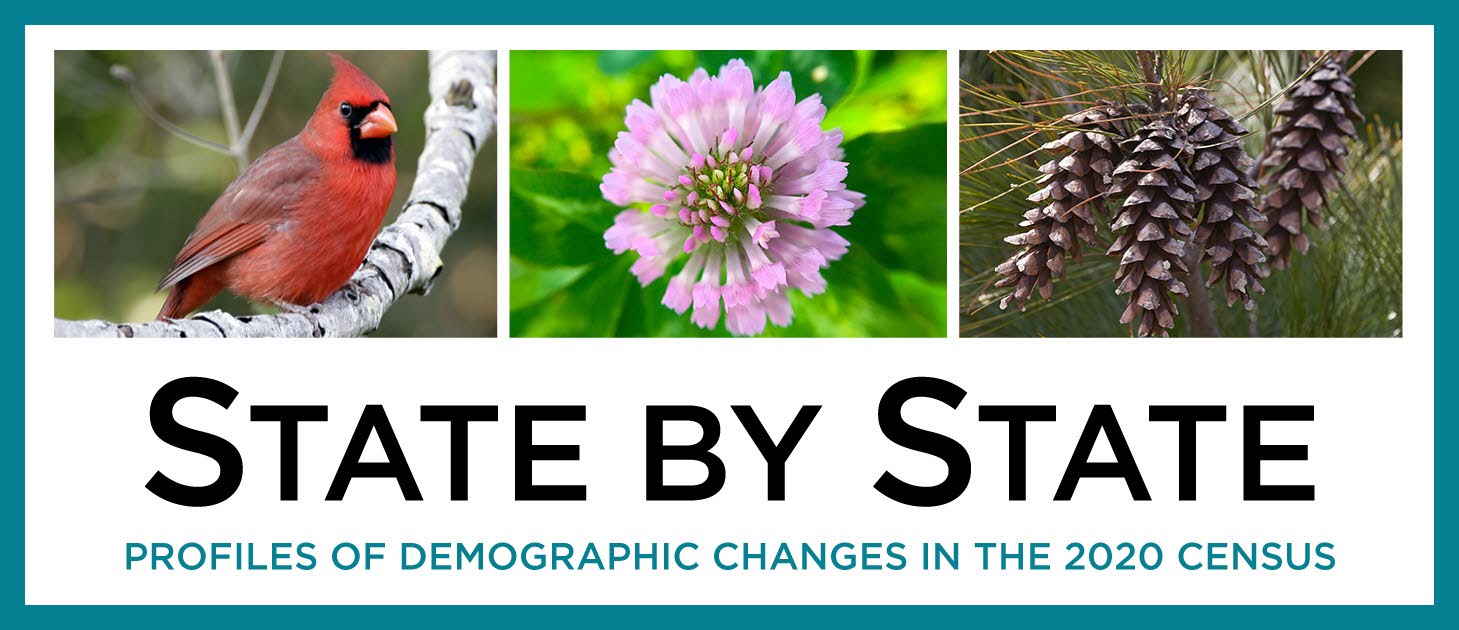Around Four-Fifths of All U.S. Metro Areas Grew Between 2010 and 2020
Over the last decade, the nation grew at its slowest rate since the 1930s, a slowdown broadly reflected in local area 2020 Census population counts released today.
Less than half of the nation’s 3,143 counties or equivalents gained population from 2010 to 2020, while the populations of around four-fifths of metro areas grew during the time period.
In 2020, 86% of the U.S. population lived in metropolitan statistical areas, up from 85% in 2010. Another 8% lived in micropolitan statistical areas, down from 9% in 2010.
Among the decade’s most notable fast-growing areas were counties in western North Dakota, led by McKenzie County which grew by 131%, and Williams County, up 83%.
In 2020, 86% of the U.S. population lived in metropolitan statistical areas, up from 85% in 2010. Another 8% lived in micropolitan statistical areas, down from 9% in 2010.
Between 2010 and 2020, the population of U.S. metro areas grew by 9%, while the population of U.S. micro areas grew by 1%. All metro and micro areas in Puerto Rico lost population during that period.
The nation’s 10 largest incorporated places (cities) all grew this past decade.
Data Visualization
County Population Change
Almost half (47%) of U.S. counties or equivalents gained population between 2010 and 2020 (Figure 1).
Five counties (metro areas in parentheses) gained at least 300,000 people during that period: Harris County, Texas (Houston-The Woodlands-Sugar Land); Maricopa County, Arizona (Phoenix-Mesa-Chandler); King County, Washington (Seattle-Tacoma-Bellevue); Clark County, Nevada (Las Vegas-Henderson-Paradise); and Tarrant County, Texas (Dallas-Fort Worth-Arlington).
California’s Los Angeles County remained the largest county in 2020, crossing the 10.0 million-person mark between 2010 and 2020.
Population Change in Metro and Micro Areas
The population of around four-fifths (81%) of U.S. metro areas increased between 2010 and 2020 (Figure 2) but only 48% of U.S. micro areas grew over the decade.
The 10 largest metro areas all grew between 2010 and 2020, led by two in Texas: Dallas-Fort Worth-Arlington and Houston-The Woodlands-Sugar Land each grew by approximately 20%.
Dallas-Fort Worth and Houston were also two of the nation’s three metro areas to gain at least 1.2 million people over the decade. New York-Newark-Jersey City, NY-NJ-PA was the third.
Five metro areas crossed the 1.0 million-person threshold between 2010 and 2020: Grand Rapids-Kentwood, MI; Tucson, AZ; Urban Honolulu, HI; Tulsa, OK; and Fresno, CA.
Among all U.S. metro areas, The Villages in Florida grew the fastest, followed by Austin-Round Rock-Georgetown, TX; St. George, UT; Greeley, CO; and Myrtle Beach-Conway-North Myrtle Beach, SC-NC.
The two fastest-growing U.S. micro areas were in North Dakota (Williston and Dickinson), followed by one each in Montana (Bozeman), Idaho (Rexburg) and Utah (Heber).
Williston, Bozeman, Rexburg and Heber were also four of the six micro areas to gain at least 15,000 people between 2010 and 2020; the other two were Hilo, HI, and Jefferson, GA.
The faster-growing micro areas tended to be located near the faster-growing metro areas, while slower-growing and declining micro areas tended to be located near slower-growing and declining metro areas.
All metro and micro areas in Puerto Rico lost population between 2010 and 2020.
Population Change in Cities
All 10 of the largest incorporated places (cities) grew in the past decade (Table 1).
Four of the 10 largest incorporated places had 2020 populations of 2.0 million or more: New York, Los Angeles, Chicago and Houston. All of the 10 largest incorporated places had 2020 populations of 1.0 million or more, including 10th ranked San Jose, California, which crossed the 1.0 million person threshold between 2010 and 2020.
State Population Change
As first reported in April (when the 2020 Census apportionment numbers were released), Texas experienced the largest numeric increase between 2010 and 2020, followed by Florida, California, Georgia and Washington (Figure 3, Table 2).
These five states accounted for nearly half of the total numeric population increase in the United States between 2010 and 2020.
Utah was the fastest-growing state, increasing by 18.4% between 2010 and 2020, followed by Idaho, Texas, North Dakota and Nevada, which each grew by 15.0% or more.
Overall, 13 states and the District of Columbia grew by 10.0% or greater. All are in the West or South regions, with the exception of North Dakota in the Midwest region. Massachusetts was the fastest-growing state in the Northeast at 7.4%.
California was the most populous state in 2020 (39.5 million), followed by Texas (29.1 million), Florida (21.5 million), New York (20.2 million) and Pennsylvania (13.0 million).
Overall, 10 states had 2020 populations of 10.0 million or greater, which together contain more than half of the U.S. population.
The populations of three states — West Virginia, Mississippi and Illinois — and Puerto Rico declined over the decade.
National Population Change
The total population of the United States on April 1, 2020, was 331.4 million, an increase of 22.7 million from 2010.
Last decade’s 7.4% increase was lower than the previous decade’s 9.7% increase and was, in fact, the lowest since the 1930s (Figure 4).
Paul Mackun is a geographer in the Census Bureau’s Population Division.
Joshua Comenetz is assistant chief of the Population Geography Staff in the Population Division.
Lindsay Spell is a geographer in the Population Division.
Redistricting Data (Public Law 94-171) Summary File News Conference
Surveys/Programs > Decennial
The U.S. Census Bureau provides the 50 states, the District of Columbia, and Puerto Rico with population counts to use in their redrawing of congressional and state legislative district boundaries — a process known as “redistricting.”
While the states are responsible for legislative redistricting, the Census Bureau provides population counts possible for the geographic areas the states need.
Redistricting & Voting Rights Data Office (RDO)
Visualizations
Data
Tables
Table
Fact Sheets
Blog Posts
Random Samplings Blog
Random Samplings Blog
Random Samplings Blog
Newsroom
Press Release
Press Release
Press Kit
Census Academy
Tutorial
Courses
Videos
Maps
Visualization



